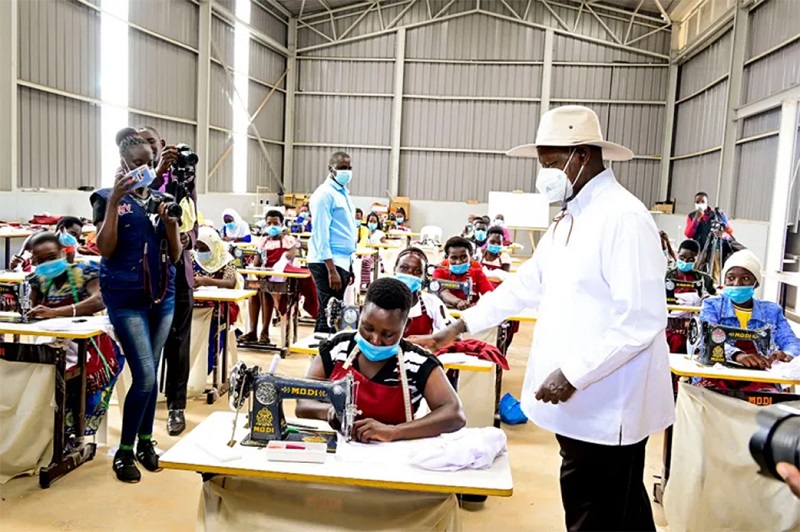
President Museveni interacts with tailoring studentsat the Masaka regional industrial hub after launching h=the Youth skilling facility in Masaka recently
Uganda has a myriad of natural beauty landmarks, which keeps on drawing visitors from all around the world to it. The natural endowments are like an addictive brew which never let go of anyone who smells its flavor.
Tourism development however depends on the modernization of infrastructure, and points to the need to intensify investment in the sector through construction of facilities for accommodation, roads, telecommunication networks, among others.
Uganda, whose tourism industry has become a major forex earner in recent years, need huge investments to harness these gains and ensure that the sector is natured to rival that of competing neighbouring countries. This requires a lot of investment.
Industry watchers have pointed out that investment in tourism infrastructure would create ready access Uganda’s endowments which include biodiversity, varied landscapes, and cultural and religious heritage.
According to Uganda Tourism Development Master Plan 2014-2024, although Uganda is relatively well endowed with accommodation and services at the high end, especially in the National Parks and other enclaves which accommodate both domestic and international visitors, bed numbers are limited and occupancy rates are low.
“Mid-market accommodation options are still limited and few are considered good value for money. At the budget end, although high occupancy rates are reported, there is demand for more good quality accommodation,” reads part of the master plan.
This is however not to forget that as recently as ten years ago, international-class hotels and restaurants were all but non-existent outside the capital.
Today, by contrast, practically every major attraction along the primary tourist circuit is serviced by one to four luxury lodges, motels and tented camps. Five-star international hotels have also cropped up to light up the hospitality market.
INVESTMENT NEEDED
Tourism sector players have however said that more investment is needed in trunk roads, public transport, budget accommodation, restaurants, and service in general.
Amos Wekesa, the managing director of Great Lakes Safaris, one of the leading tour companies in Uganda, said even if Government needed $30m to market the country to get 3 million tourists, the benefits at the airport alone are ten times the amount of money they would have invested.
“An average tourist eats two eggs every day and spends 8 days in the country. This benefits the hotel industry and common poultry farmer, boosting the entire economy. Government needs to exercise its muscle in erecting tourism infrastructure all around the country if Uganda is to optimally earn from the sector,” he said in a recent interview.
Wekesa called upon Government to establish a fund for erection of tourism infrastructure and promotion, saying it will boost the entire economy and enable the authorities’ replicate earnings that would trickle down to the common man.
Odrek Rwabwogo, the Chairman, Presidential Advisory Committee on Exports and Industrial Development (PACEID), said tourism is a sector which Government can use to bring in the much needed dollars and create an export-led economy in a period of just five years.
“Tourism is a rife sector ready to be harvested. Our strategy to make Uganda exports earn up to $12b in the next five years can greatly be driven by tourism,” he said in a recent interview.
PACEID has been tasked with improving Uganda’s foreign earnings from the current $6b to $12b and beyond from the prioritised 13 key products which include tourism, coffee, tea, fruits and vegetables, beef, diary, grains, sugar, fish, banana flour, flowers, cement and steel.
PRESIDENTIAL INTERVENTION
While addressing trade representatives, MDA’s and the private sector at the Annual Trade Representative Forum (TRF) at State House Entebbe recently, President Yoweri Museveni hailed Uganda’s climate saying it is the best and favorable for tourists around the world especially now that Uganda is more peaceful than ever before.
“We used to have problems of lack of peace in the past but that stopped long ago. The only issue is now promotion,” he said.
He added that the government has made it a priority to improve the infrastructure to make it easy for tourists, since setting up airfields in different tourist destinations is top on agenda.
“There is need to build more Airfields near the national parks. This is because some of the rich people don’t have time to come and land at Entebbe and drive 500 miles to Kidepo National Park. It’s only small people who can manage to do that but the rich people want to come in their private jets, land in the national park and then fly out. So, we shall have to build more hard surface airports in Kidepo, Kasese, Kihiihi, Gulu etc.,” the President said.
Daudi Migereko, the Uganda Tourism Board Chairman called upon the Ministry of Works to have an emergency program to develop the roads with high tourist demand.
He said since President Museveni launched Uganda’s destination brand in January 2022, the country’s tourism has been getting very good ratings to unprecedented levels.
“We have received awards and endorsements from international media houses and organisations since then,” he said, adding that prior to Covid-19, tourism was Uganda’s number one foreign exchange earner fetching the country $1.6b and that it had been predicted that Uganda would be among the 10 fastest growing fastest destinations for leisure, travel and spending between the year 2020 and 2026.
Concerning tourism roads, Gen. Edward Katumba Wamala the works and transport minister said Government is looking at developing key transport and infrastructure projects that can drive Uganda’s Exports Competitiveness.
“Government is addressing the few pockets of poor road networks which are
making goods expensive on the market,” he said, adding, “We have harmonized our laws within the country and the region to support regional trade and to ease movement of goods, services and tourists.”
Wamala said they are also implementing key infrastructural development like the one stop border posts to facilitate easy movement of goods, services and people, among which are domestic and international tourists.
HOTELS NEEDED
According to the ministry of Tourism, Wildlife and Antiquities, by 2013, hotel establishments in Uganda were estimated to be 2,678, while currently, they are in the region of 3,500 with over 20,000 rooms and 30,000 beds.
Members of the Uganda Hotel Owners Association (UHOA) have henceforth called upon Government to invest more in marketing the tourism landmarks and infrastructure if the sector is to grow and flourish.
They called upon Government to capitalize the Hotel and Tourism Training Institute, to allow existent hotels to send in their staff for refresher courses.
Wekesa, a member of the body, and also Presidential Adviser on Tourism, hailed President Museveni for listening to players in the industry and launching a moderate initiative to boost the tourism industry and expand the infrastructure as it looks at absorbing the anticipated income.
He said tourism must be taken seriously since it has the potential to absorb thousands of unemployed and underemployed youth. “It will not only boost forex earning for the country but also offer thousands of employment opportunities to deserving Ugandans,” he said recently.
TOURISM LANDMARKS
John Walugembe, the managing director, federation of small and medium sized enterprises said tourism has been a major growth industry globally for over five decades, pointing out the factors underpinning this growth as growth of incomes and wealth, improvements in transport, changing lifestyles and consumer values.
Others include, increased leisure time, international openness and globalization, immigration, special events, education, information and communication technologies, destination marketing and promotion, improved general and tourism infrastructure.
According to the World Bank, Infrastructure development plays an important role in determining the level of tourism development.
“It should, however, be noted that as much as infrastructure facilitates tourism development, some infrastructural developments may become tourist attractions in themselves such as bridges, dams, and stop over points.”
It says for a destination to exploit its resources, there is need for appropriate infrastructure in place in terms of a transport network (roads, air water and railway transport), hospitality facilities (accommodation facilities, restaurants) and support infrastructure (power, water, Internet, signage etc).
ROADS WANTING
Some of Uganda’s historical sites such as Fort Patiko in Gulu, the Tanda Archeological site in Buganda, and Nyero Rock paintings in Teso, are unreachable because of persistent neglect and poor roads leading to them.
The Uganda Tourism Development Master Plan 2014-24 further points out that roads providing important access to key tourist sites are in poor condition.
It pinpoints roads around Bwindi Impenetrable and Mgahinga National Park, the route from Kasese to Nyakalengija that allows tourists access to Rwenzori
Mountains National Park, and access road between Bwindi Impenetrable and Queen Elizabeth National Parks.
“As a result of the poor road network, tourists visiting these attractions spend a great proportion of their stay in Uganda travelling in uncomfortable conditions, limiting their desire and available time to visit additional destinations. The poor condition of these roads constrains access to the most important parks, but also prevents the growth and development of destinations that are not well connected to the transport network,” it reads in part.
The masterplan further stipulates that whereas Kidepo Valley National Park is one of the country’s most attractive parks, it is difficult to access and has a travel time by road of typically 12 hours or more from Kampala.
Sam Mwandha, the Executive Director Uganda Wildlife Authority (UWA), however points out that all is not lost. He says the 88.520km long Kabale-Kisoro-Bunagana Road, which is located in the south-western corner of Uganda in the districts of Kabale and Kisoro is far better than it was 10 years ago.
“It starts at Kabale Town, connects to Kisoro Town and onwards to the border with the Democratic Republic of Congo at Bunagana, opening the whole area up to tourists,” he said
NUMBERS VS FACILITIES
After hosting 100 destination buyers, journalists, and 150 exhibitors of services providers during the concluded Pearl of Africa Expo (POATE) 2023, the Uganda Tourism Board (UTB) not only expects the volume of tourists to shoot up, but to out striping the existent facilities.
Cuthbert Ncube, the African Tourism Board President said it will take good infrastructure to make exploring Uganda a priority for visitors coming to Africa.
“As POATE grows Uganda has the potential to become a tourism Mecca on the African continent,” he pointed out during his talk at the event.
He said well-developed facilities at tourism sites and infrastructure like tourism roads would influence a high level of tourists to explore Uganda and also give tourists a better experience through which they can influence other tourists to come and visit Uganda.
Tom Butime, the tourism minister under scored Government’s commitment to work on Uganda’s tourism infrastructure, adding that Kabale International Airport is destined to be completed in the financial year 2023/24 and that plans to work on many other tourism infrastructures are in the pipeline.
He said the works ministry has undertaken feasibility studies of expanding some aerodromes that fall in the tourism circuit. They include Kidepo, Kisoro, and Pakuba.
The level and quality of tourism infrastructural development will determine the level of tourists’ satisfaction and influence the choice of destination.
A mended infrastructure will henceforth underwrite insufficient quality of transport within Uganda, which has been the main cause of dissatisfaction cited by international tourists visiting the country.




